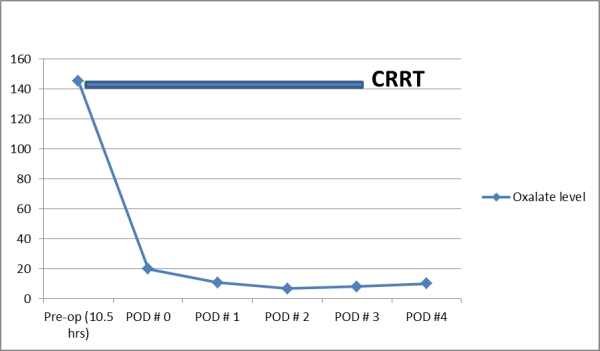Successful Management of Simultaneous Liver-Kidney Transplant Recipient with Primary Hyperoxaluria Using Intensive Continuous Dialysis
Nephrology, University of Virginia, Charlottesville, VA
Transplant Center, University of Virginia, Charlottesville, VA.
Meeting: 2018 American Transplant Congress
Abstract number: C164
Keywords: Graft survival, Kidney/liver transplantation
Session Information
Session Name: Poster Session C: Kidney Technical
Session Type: Poster Session
Date: Monday, June 4, 2018
Session Time: 6:00pm-7:00pm
 Presentation Time: 6:00pm-7:00pm
Presentation Time: 6:00pm-7:00pm
Location: Hall 4EF
The rate of oxalate production in patients with Primary Hyperoxaluria type 1 (PH-1) exceeds the rate of removal, leading to progressive worsening of kidney function. Simultaneous liver-kidney transplantation is the treatment of choice for this disorder. It is well known that excess oxalate is mobilized from the tissues after transplantation and jeopardizes the function of the new kidney. Intensive dialysis is recommended to decrease the risk of allograft loss, but what defines the intensity of dialysis is not clear in the literature and there are no specific guidelines regarding perioperative management. Herein, we present a case of PH-1 managed with pre, post and intra-operative CVVHF, with successful control of oxalate levels below solubility threshold.
A 21 y.o. Caucasian male with PH-1 diagnosed at the age of 8 yrs in the setting of recurrent nephrolithiasis, presented with progressively worsening kidney disease, and started hemodialysis one year prior to transplant. Upon admission for a simultaneous liver and kidney transplantation he was found to have a very high serum oxalate levels (145.2 micro mol/L). CVVHF was started early on admission (10.5 hours before surgery), continued Intra-operatively, and until POD #3. His Plasma oxalate levels are shown below. Post-operatively, the patient was maintained on high fluid intake, low oxalate diet and vitamin B-6. Immediate post- transplant discharge creatinine was 1.8 with oxalate level of 6.2. Ten months after transplant, the patient continues to do well with a serum creatinine of 1.5 mg/dL and no stone episodes. The liver allograft is also in excellent condition with normal liver function tests.
CVVHF is an effective modality in reducing serum oxalate levels. Our experience highlights the importance of prompt initiation of intensive continuous hemodialysis pre-operatively, and continued support through surgery and early post-operative course, in order to minimize post-transplant complications due to oxalate mobilization.
CITATION INFORMATION: Abdelaziz A., Nishio-Lucar A., Doyle A., Pelletier S., Rasmussen S., Lobo P., Warburton K. Successful Management of Simultaneous Liver-Kidney Transplant Recipient with Primary Hyperoxaluria Using Intensive Continuous Dialysis Am J Transplant. 2017;17 (suppl 3).
To cite this abstract in AMA style:
Abdelaziz A, Nishio-Lucar A, Doyle A, Pelletier S, Rasmussen S, Lobo P, Warburton K. Successful Management of Simultaneous Liver-Kidney Transplant Recipient with Primary Hyperoxaluria Using Intensive Continuous Dialysis [abstract]. https://atcmeetingabstracts.com/abstract/successful-management-of-simultaneous-liver-kidney-transplant-recipient-with-primary-hyperoxaluria-using-intensive-continuous-dialysis/. Accessed December 15, 2025.« Back to 2018 American Transplant Congress

